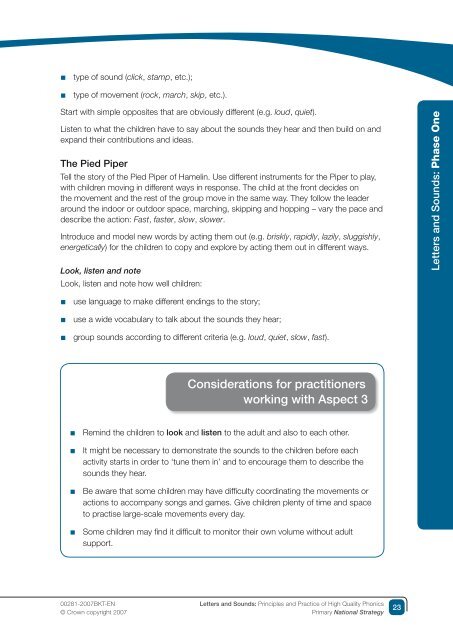Letters and Sounds 1
Letters and Sounds 1
Letters and Sounds 1
You also want an ePaper? Increase the reach of your titles
YUMPU automatically turns print PDFs into web optimized ePapers that Google loves.
■ type of sound (click, stamp, etc.);<br />
■ type of movement (rock, march, skip, etc.).<br />
Start with simple opposites that are obviously different (e.g. loud, quiet).<br />
Listen to what the children have to say about the sounds they hear <strong>and</strong> then build on <strong>and</strong><br />
exp<strong>and</strong> their contributions <strong>and</strong> ideas.<br />
The Pied Piper<br />
Tell the story of the Pied Piper of Hamelin. Use different instruments for the Piper to play,<br />
with children moving in different ways in response. The child at the front decides on<br />
the movement <strong>and</strong> the rest of the group move in the same way. They follow the leader<br />
around the indoor or outdoor space, marching, skipping <strong>and</strong> hopping – vary the pace <strong>and</strong><br />
describe the action: Fast, faster, slow, slower.<br />
Introduce <strong>and</strong> model new words by acting them out (e.g. briskly, rapidly, lazily, sluggishly,<br />
energetically) for the children to copy <strong>and</strong> explore by acting them out in different ways.<br />
Look, listen <strong>and</strong> note<br />
Look, listen <strong>and</strong> note how well children:<br />
■ use language to make different endings to the story;<br />
■ use a wide vocabulary to talk about the sounds they hear;<br />
■ group sounds according to different criteria (e.g. loud, quiet, slow, fast).<br />
00281-2007BKT-EN<br />
© Crown copyright 2007<br />
Considerations for practitioners<br />
working with Aspect<br />
■ Remind the children to look <strong>and</strong> listen to the adult <strong>and</strong> also to each other.<br />
■ It might be necessary to demonstrate the sounds to the children before each<br />
activity starts in order to ‘tune them in’ <strong>and</strong> to encourage them to describe the<br />
sounds they hear.<br />
■ Be aware that some children may have difficulty coordinating the movements or<br />
actions to accompany songs <strong>and</strong> games. Give children plenty of time <strong>and</strong> space<br />
to practise large-scale movements every day.<br />
■ Some children may find it difficult to monitor their own volume without adult<br />
support.<br />
<strong>Letters</strong> <strong>and</strong> <strong>Sounds</strong>: Principles <strong>and</strong> Practice of High Quality Phonics<br />
Primary National Strategy<br />
<strong>Letters</strong> <strong>and</strong> <strong>Sounds</strong>: Phase One
















